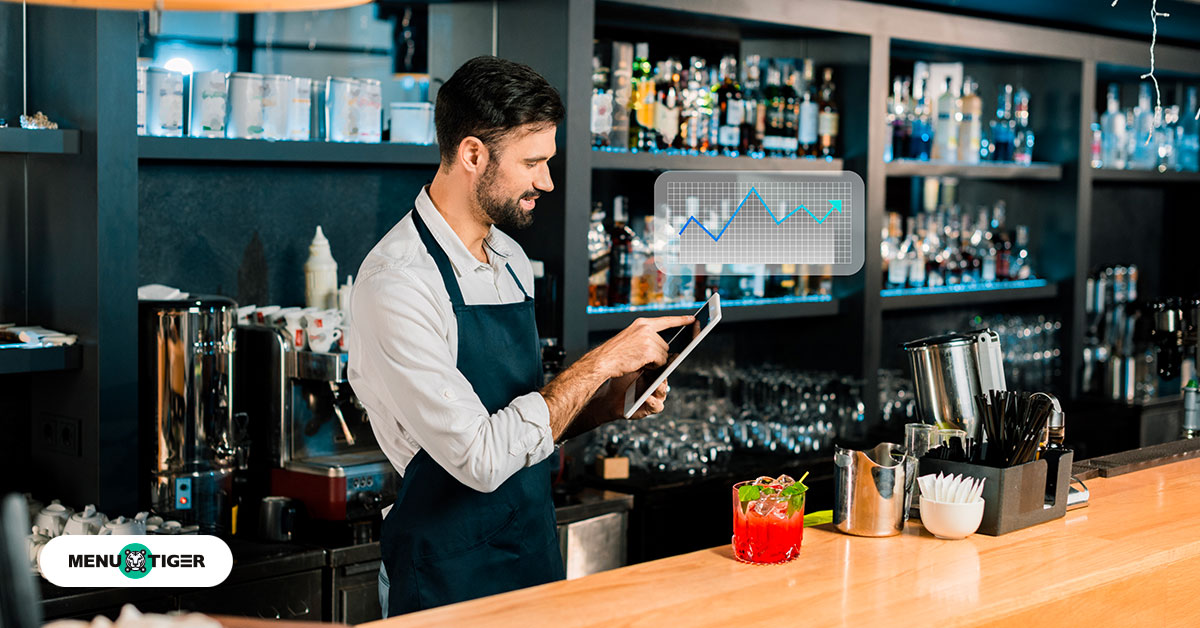
Bar Industry Trends, Statistics, and Strategies in 2025
Last Updated: July 18, 2025
A shot of tequila may not be enough to get a person drunk. In the same way, a simple marketing initiative won’t get your business buzzing in the saturated bar industry.
To make your business lead the line, you need to understand what’s going on: be it on what is trending or how you market your bar effectively by just using a QR code menu.
That’s why we’ve prepared this comprehensive guide on statistics, trends, and marketing for you to level up and completely reach a successful business journey.
Bar industry statistics, market size, and growth
It’s crucial for you as a business owner to have data on what’s going on in the industry you’re part of.
This is essential if you want to make informed decisions for your business.
So, here are important reports in the bar industry that you need to take note of.
Bars and nightclubs have a notable impact on the U.S. economy
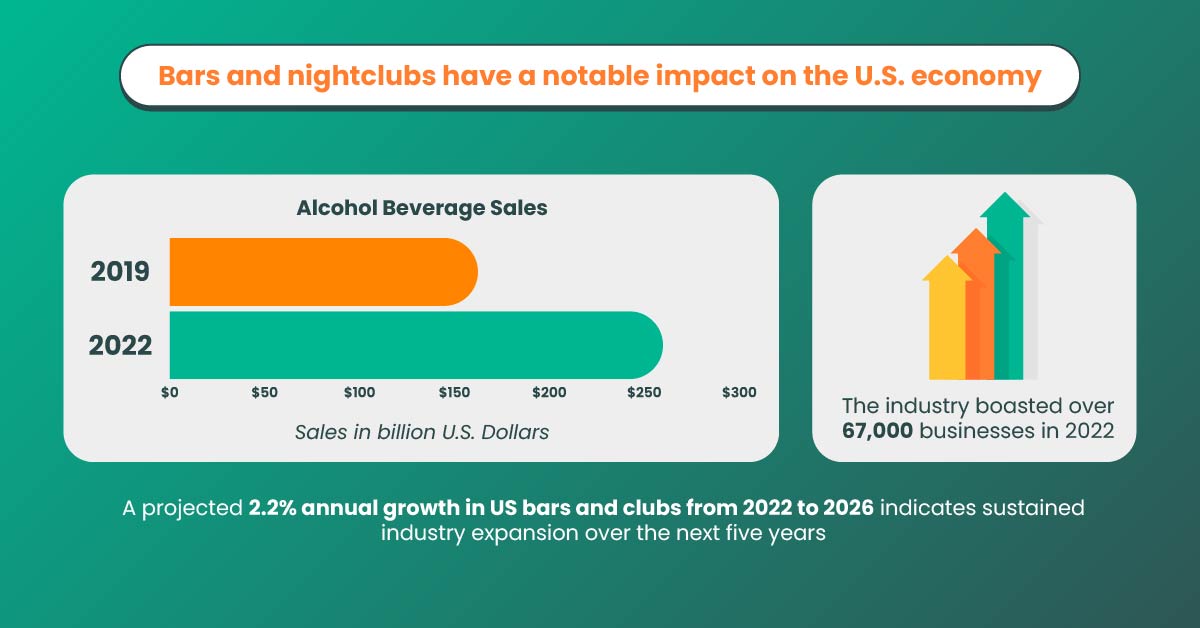
- According to the Gitnux market data report, total alcohol sales reached $162.3 billion both for retail and on-premise sales. This only proves the industry’s enormous economic influence from the sales generated each year.
- A report from Statista revealed that in 2022, the sales of alcoholic beverages reached $259.8 billion. This growth comes from the increased popularity of spirits and wines in the market.
- In the same year, the number of businesses in this sector grew to more than 67,000.
- There’s a 2.2% annual growth of US bars and clubs in 2022-2026, which shows a great indication of the bar industry’s future as the sector is most likely to experience steady growth for the next five years.
The global alcoholic and non-alcoholic beverage market size
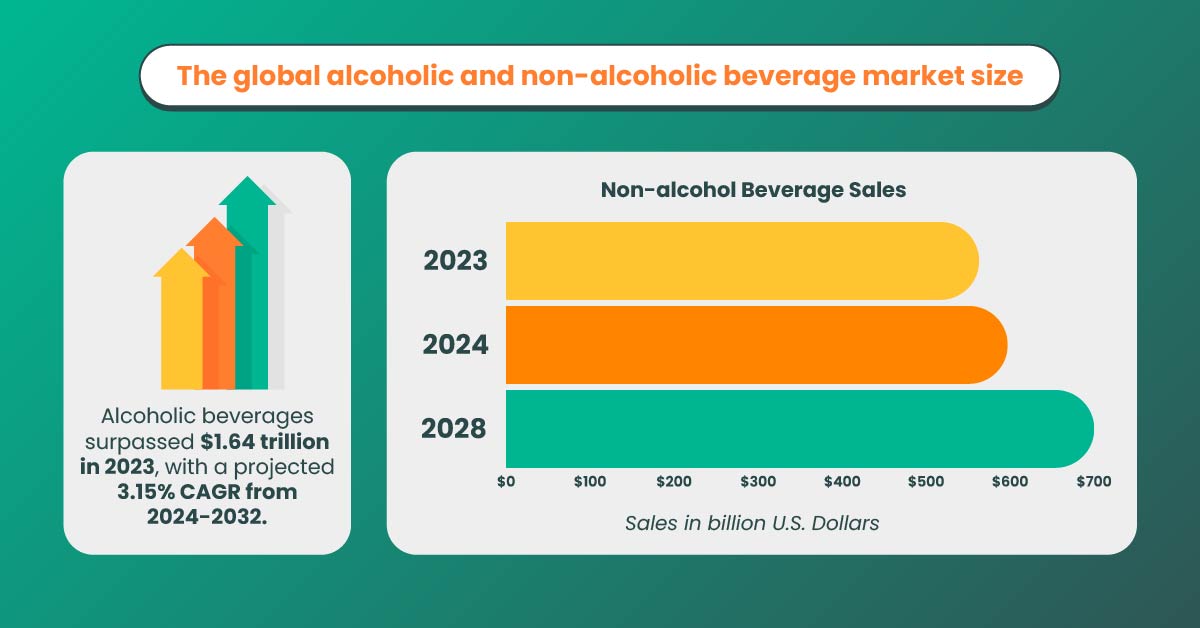
- A market size report from Strait Research indicated that alcoholic beverages reached more than $1.64 billion in 2023, which is forecasted to grow by a compound annual growth rate (CAGR) of 3.15% from 2024 to 2032.
The market has been prospering due to various developments and innovations in producing vodka, wine, beers, and cocktails, together with evolving customer tastes and lifestyles.
- For non-alcoholic beverages, the market size was valued at $563 billion in 2023 to $597 billion in 2024 at a CAGR of 5.9%. It is also forecasted to grow by a CAGR of 5.3% in 2028, amounting to more than $700 billion.
The rise of functional drinks influences this growth, changing consumer demographics, branding and marketing strategies of bars and restaurants, cultural influences, and the emphasis on sustainability.
Additionally, the forecasted increase in market value can be attributed to the demand for sugar and natural sweeteners and health immunity benefits.
Alcoholic and non-alcoholic beverage revenue statistics worldwide
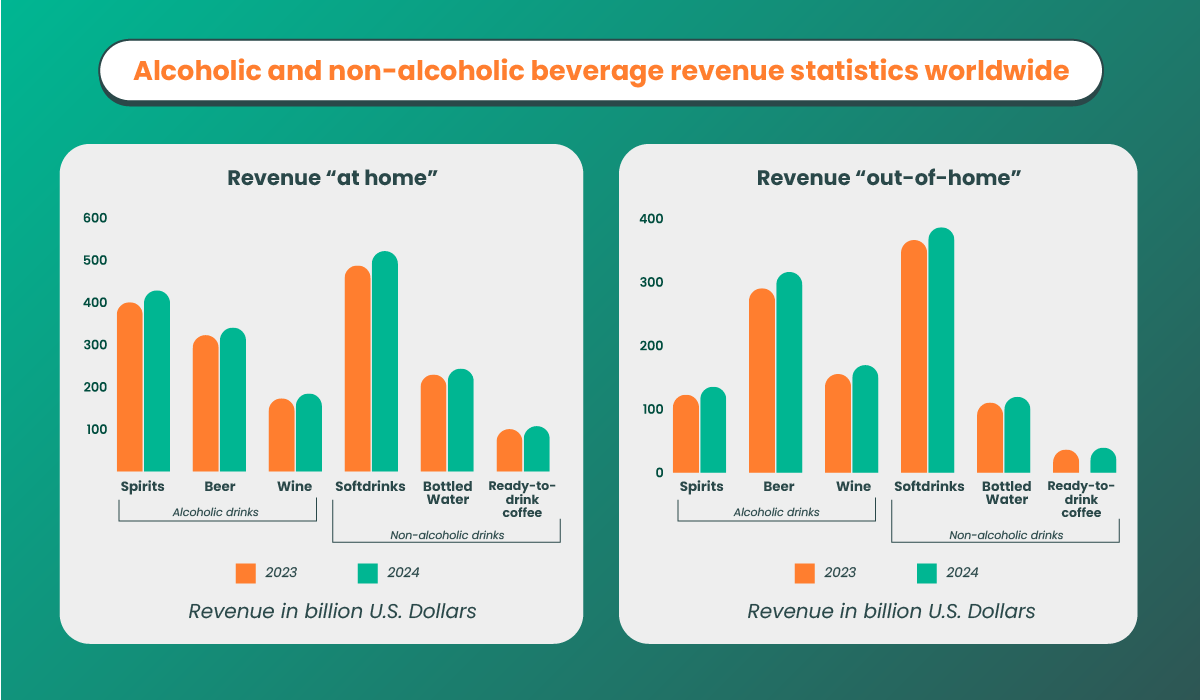
- Spirits took the top list in 2023 with a total revenue at home of more than $400 billion, followed by beer with $322.2 billion and wine with $172.6 billion. These top three popular beverages have increased in 2024 by $428 billion, $340 billion, and $184.2 billion, respectively.
- Comparatively, revenue, out-of-home recorded $122.4 billion for spirits, $290 billion for beer, and $155 billion for wine for 2023. There’s a slight increase this year, which garnered $135 billion, $315.7 billion, and $169 billion.
- The revenue change, as per Statista's report, is due to premiumization. Customers are continuously seeking unique and premium alcoholic beverages, leading to the rise of crafted beers, artisanal spirits, and wines.
- For non-alcoholic drinks, soft drinks gained the highest revenue at home, amounting to $487 billion in 2023, followed by bottled water with $229 billion and ready-to-drink coffee and tea with $100 billion. In 2024, there has been a recorded increase in revenue of $521 billion, $243 billion, and $Top billion.
- Revenue out-of-home for non-alcoholic beverages is slightly low with these three top non-alcoholic drinks. For 2023, soft drinks garnered $366 billion, bottled water has $110 billion, and RTD coffee and tea with $36 billion. The following year, there’s a slight increase that amounts to $386 billion, $119 billion, and $39 billion, respectively.
- Customer preferences play a crucial role as a driver of the growing market for non-alcoholic drinks, which influences an increased demand for healthier beverage options. This leads to the rise of non-alcoholic beverages without sugar.
Growth of the bar industry in the coming years

- According to the Verified Market Research report, there’s an expected growth in market size by 2030 valued at $124 billion, growing a CAGR of 3.40% during the forecasted period 2024-2030. This predicted growth gained a 26% increase in value from 2023.
The market drivers for this development are influenced by various factors such as shifting customer tastes, population growth and urbanization, financial stability, innovation in entertainment, social media marketing, integration of technology, and other trends in health and wellness.
9 bar trends to add to your business
Staying attuned to each emerging bartending trend is essential in today’s experience-driven bar landscape.
For bar owners and industry innovators, trends offer strategic opportunities to reimagine offerings, refine operations, and meet the expectations of a more discerning clientele.
Low-ABV and non-alcoholic options
The market value report of non-alcoholic products grew by 9% in 2022 from 65% in 2018.
According to the IWSR report, non-alcohol volumes are forecasted to grow at a CAGR of +9% between 2022 and 2026.
The drivers for this growth in the consumer category are Gen Z (legal-drinking age), with France having the highest number of new recruits, with 25% of non-alcohol drinkers joining the category.
Additionally, the US has recorded 43% of non/low Millennial consumers, which is by far the largest group.
With this demand on the market, offering a diverse selection of your drink menu helps you cater to this type of consumer.
Add various mocktails, low-alcohol by volume (ABV) and non-alcoholic beers, and creative zero-proof cocktails to your menu to provide wider options for your customers and accommodate their range of preferences and dietary choices.
These will not only provide them with flavorful alternatives to traditional alcoholic beverages but also contribute to raising awareness of social responsibility by promoting moderation and wellness beverages.
Sustainable practices and eco-conscious bar operations
Eco-conscious business operations in the hospitality industry have become increasingly important in recognizing the importance of environmental stewardship.
In fact, a survey from McKinsey & Co. resulted in 66% of the respondents considering sustainability when they make a purchase. This determines their buying behavior—consumers connect themselves with brands that align with their values and priorities.
As your bar’s position is considered one of the top industries, you can adopt a variety of sustainable initiatives to minimize environmental impact and promote eco-consciousness practices.
You can start by sourcing local and organic ingredients to reduce your carbon footprint, minimizing food and beverage waste through careful inventory management using a bar and restaurant inventory system and composting.
Replacing packaging with biodegradable straws, stirrers, and glassware can help.
Go for a themed bar
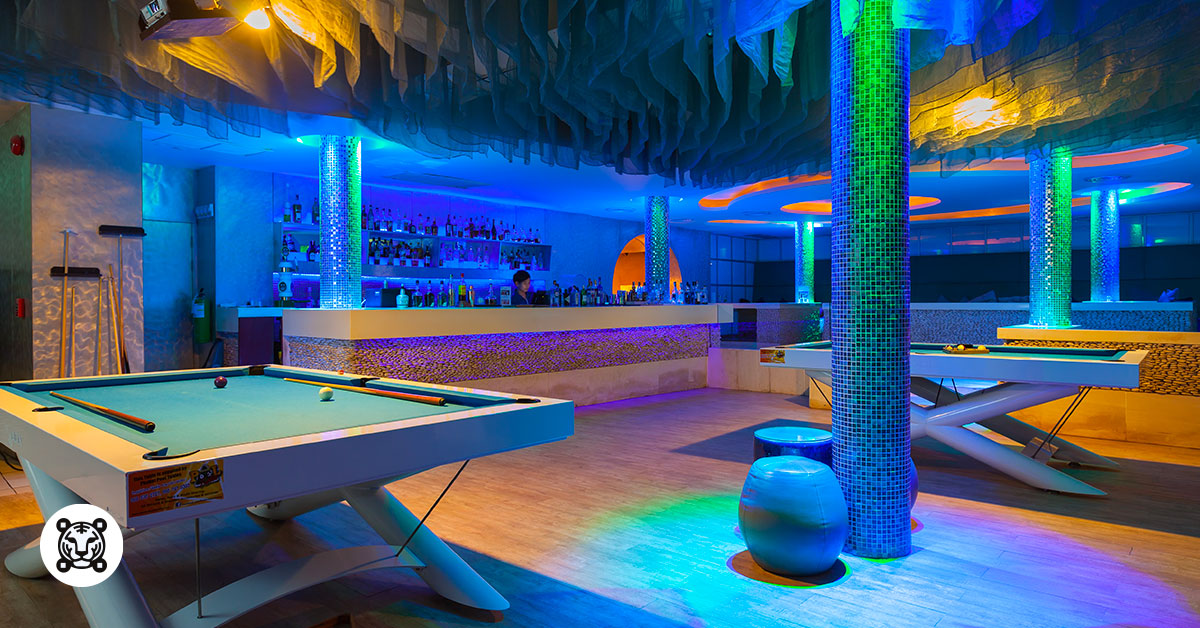
Make your bar more than just a venue to drink but a space where you can provide immersive and memorable experiences that can transport them to different times and places.
Go beyond the traditional look by creating a unique atmosphere, decor, and entertainment that align with your specific theme or concept.
For example, you can go for tropical decorations and couple these with exotic cocktails or a futuristic bar with sci-fi aesthetics.
Creating an identity for your business through a theme or concept gives opportunities for your creativity and innovation to flourish, allowing you to showcase your passion for storytelling, design, and hospitality while delivering the best service to your patrons.
Health and wellness food and drinks menu
After the wave of the global pandemic and now facing the new normal, consumers tend to seek fun yet healthy options when going to bars, restaurants, and even in stores.
Another survey conducted by McKinsey and Company in 2022 revealed that at least 70% of the respondents want to be healthier, and about 50% of consumers across age brackets believe that healthy eating is a top priority.
So, it is advantageous for you to support these goals by offering healthy food and drink pairing ideas in your bar.
Here is a list of combos you can add to your menu:
- Edamame with chili garlic oil with sparkling water, muddled cucumber and mint
- Grilled shrimp skewers and light lemon herb dressing paired with non-alcoholic mojito
- Veggie crudites with hummus and low-ABV spritzer for a light buzz
- Cauliflower steak and a chimichurri sauce with a glass of red wine
- Chicken or tofu lettuce wraps with Kombucha on tap
Globally inspired flavors
Bring global tastes to your bar to give your customers a world tour through your menu that celebrates the rich diversity of cultures and cuisines.
Drawing inspiration from diverse culinary traditions, your bar menu ideas should feature innovative fusion dishes and drinks that marry traditional techniques with modern twists.
Technology integrations
Make your operations even more streamlined by adding technologies to your business.
One of these is inventory management software, which can help you optimize stock levels to ensure ingredients are always available.
Of course, we can’t leave out the QR code menu that helps expedite the order-taking process with a simple phone scan.
Customer relationship management (CRM) systems can also help you personalize marketing initiatives that can foster customer loyalty through target rewards.
You can consider adding tableside tablets or kiosks to your list that can empower guests to control their dining experience.
Last but not least, social media for restaurants and bars can assist you in amplifying your brand’s visibility and engagement, which can potentially attract new patrons through interactive posts and ads.
Embracing these technological integrations can enhance the efficiency of your overall service.
Pop-up stores
These can give your bar business a unique opportunity to expand its brand presence, generate excitement, and increase revenue.
Pop-up stores can take various forms, such as a temporary retail space within the bar itself or a separate location in a highly dense area.
You can use these to sell branded merchandise such as glassware, apparel, cocktail kits, or specialty ingredients used in your signature drinks.
Additionally, you can collaborate with local artists, designers, or vendors that offer exclusive products or limited-edition items that reflect the bar’s identity and aesthetic.
Bartending shows
As part of today’s evolving bartending trends, consider hosting regular flair bartending shows to spotlight your staff’s skill, creativity, and showmanship while preparing drinks.
Through this, you’ll be able to interact with your customers up close, creating a lively atmosphere that encourages participation and socialization.
This show can also serve as a promotional activity that can draw attention to the bar’s unique offerings, ensuring an increase in sales and differentiating your business from other establishments.
Subscription services for craft cocktails and beers
Craft cocktail and beer subscription services offer guests the opportunity to explore a curated selection of artisanal drinks delivered directly to their doorstep on a regular basis.
Subscribers typically receive a variety of handcrafted cocktails or specialty beers, often accompanied by ingredients, recipes, or tasting notes to enhance their experience.
Offering this kind of service to your patrons allows them to gain access to your exclusive products, limited-edition releases, and expertly curated selections that may not be readily available elsewhere.
It will help you generate recurring revenue, increase your business’s brand awareness, and foster a loyal customer base.

7 ways to effectively market your business as per industry statistics and trends
Now that you know the industry's current trends, it's time to equip your business with the best bar marketing ideas, which will surely help you stay ahead of the curve.
Here is a list of ways to market your bar, responding to your target customer base:
Focus on enhancing your presence online
You’ve probably created a section on your website where you introduce the history of your bar or provide some other information about your offerings.
But take note that this platform can be a driving force for prospective customers to visit your business.
That’s why it’s essential for you to enhance your website into a more interactive and informative digital space that can transport readers to your bar.
Here are a few suggestions you might want to try:
- Make sure to have an appealing and user-friendly site.
Reflect your bar’s branding on your website so you can set the expectations for your customers. Use high-quality photos and videos that complement your content that can grab the attention of your readers.
- Check the mobile responsiveness of your webpage.
The formats of your content should be mobile-friendly to cater to those who are always on the go. This means you should be aware of the spacing, font, and image sizes, making your content easier to digest.
- Tell them what to do.
Don’t leave your visitors guessing what you want them to do next. So, include clear call-to-actions (CTAs) throughout your website, whether it’s subscribing to a newsletter, contacting you, or making a purchase.
Look for partnerships with other local business
Local business partnerships can be a win-win for your bar, bringing in new customers and exposing you to a wider audience.
Start by identifying businesses that complement yours but don’t directly compete. This could be restaurants, cafes, comedy clubs, art galleries, or even themed parks.
Assess if these businesses attract a similar audience to your bar in order to align your goals for a successful partnership.
This marketing strategy—if done properly, could be beneficial for you in that you can organize co-sponsored events, allowing for cross-promotion with each other’s businesses.
Other than that, you can create bundled packages that combine your offerings and theirs. Let’s say a dinner and drinks combo with a nearby restaurant or a ticket to a local show paired with a discounted beverage offer at your bar.
Analyze your sales report
Your sales report is a treasure trove of information where you can gain valuable insights that will guide your bar’s marketing efforts.
Analyzing it regularly can help you stay on top of trends and ensure you respond immediately to changing customer preferences and sales patterns.
To help you gather those, here is a list of things you need to do:
- Best-selling beverages. Identify the drinks that consistently fly off your shelves and ask yourself the following question: Are there specific types of cocktails, beers, or wines that dominate sales? This tells you what your customers crave for and enhances your future promotions.
- High-profit margin items. Go beyond just your sales volume. Look at your profit margins for each drink. Are they surprisingly highly profitable items that you can highlight in your marketing?
- Food movers. If you have a food menu, analyze which dishes are most popular. Consider pairing them with specific drinks in your marketing materials or offering special combo deals.
- Sales by Day/Time. Track sales trends by day and time and target your marketing efforts accordingly. Offer happy hour specials on slow nights or host themed events to draw in a crowd.
- Seasonal shifts. See if there are seasonal patterns in your sales data. Do sales of specific drinks spike in the summer or during holidays? Adapt your marketing to capitalize on these trends.
Upsell other items in your bar
Frame your upselling strategy as adding value to their experience, not just increasing the bill.
Explain how the suggested item complements their choice in terms of flavor or textures.
But don’t pressure your customers on a single upsell. Instead, provide a few options at different price points to allow them to select what fits their budget or preference.
With this, you can upsell additional items at your bar in a way that enhances the customer experience, increasing sales and strengthening your reputation for providing a welcoming and enjoyable atmosphere.
Offer a loyalty program for your patrons
If you don’t offer a loyalty program for your valued customers yet, now is the time to provide one.
When designing your rewards program, keep it simple for your customers to easily understand and participate in. Avoid overly complex point structures or redemption processes.
Next, though optional, consider a tiered system with increasing benefits for loyal customers. This will motivate them to climb the tiers through more visits or spending.
Offer also various reward options that can cater to different preferences. It could be freebies, merchandise, or exclusive event access.
Make sure to make the enrollment for your program effortless. Offer sign-up options through a mobile app, website, or a digital menu QR code at your bar.
Use your social media
It’s non-debatable how effective social media marketing is.
In the recent Adobe study, it was then observed that 50% of Gen Z and 42% of millennials find social media relevant as an advertising channel.
In fact, based on Statista's findings, 37.9% responded to a survey they purchased after seeing an advertisement on social media.
That’s what we’re going to explore deeper in this section.
To effectively maximize your social networks, identify the time of the day when the audience is mostly active. This increases the likelihood of engagement with your posts.
More active users means more opportunities for likes, comments, shares, and clicks, amplifying the reach and visibility of your content.
Also, create and share high-quality content that resonates with your audience. Use a mix of formats such as images, videos, infographics, and text-based posts to keep your feed dynamic and interactive.
Don’t forget to use hashtags to increase the discoverability of your content and reach a broader audience. Research popular and niche hashtags related to your industry and brand to maximize visibility.
Leverage on QR code menus
Let’s face it: most people these days are glued to their phones, and a smart menu gives your bar a modern, tech-forward feel.
With this, you can streamline your order-taking processes by letting your customers scan the code using their smartphones and make their transactions.
There’s no need for bulky printed menus that can take up so much in your table space. This single-square technology displayed on each counter or coaster can do the trick.
If you’re running daily or weekly specials, you can update your digital menu in seconds, keeping your customers in the loop about the latest updates in your bar.
QR code menu software: A bar marketing tool you need today
The hard truth is that running a bar business isn’t an easy job to do.
Because of the evolving preferences of your customer base, you also need to keep on experimenting with your offerings in order to cope with changes.
Aside from that, strategizing how you’re going to improve your service, operations, and whatnot can take up so much of your money and time.
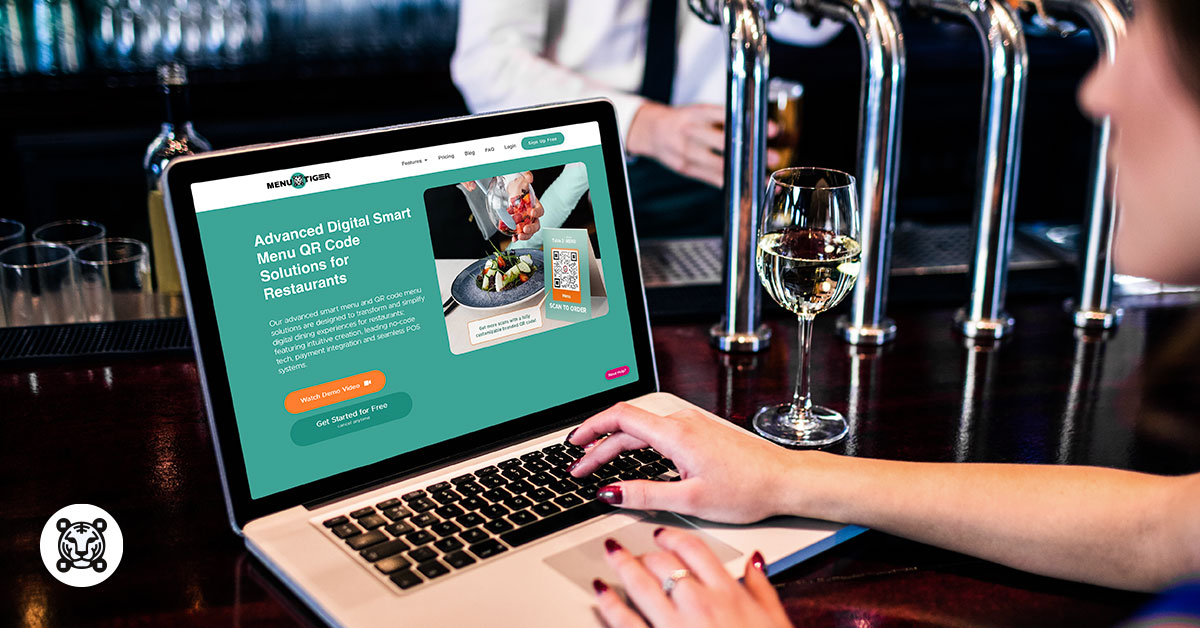
Here’s where QR code menu software like MENU TIGER comes in.
It is not only designed to provide ways to simplify your workflow but helps you effectively navigate effective marketing strategies for your business.
Upselling and cross-selling opportunities
MENU TIGER’s advanced add-ons feature gives you an opportunity to make combo offers with your low-profitable items and those with high-profit margins.
This will greatly help increase your sales volume and empty shelves for new stocks.
Efficient personalized marketing
With the help of email marketing campaigns, you’ll be able to connect with your target audience through a bar and restaurant newsletter that can provide a platform for you to run personalized promotions based on your customers’ interests and preferences.
Hassle-free order-taking process
Your guests can order, pay, and scan the menu QR code without having to wait in line at your counter.
You can manage these orders and link the software to your POS system from your admin panel.
Pro tip: Just make sure to put clear instructions on how to scan a menu QR code in order to avoid any misunderstandings and errors, making the process even more easy for your guests.
Generate sales analytics
You can make informed business management decisions with the aid of the valuable data gathered from your day-to-day operations.
Customer feedback collection
You’ll be able to collect customer feedback easily with MENU TIGER’s survey tool. This data can be used to improve your overall bar services.

Tap in, toast up: Let’s raise your ‘bar’ high with MENU TIGER QR code menu software
The bar industry is indeed congested with the growing number of businesses established each year and the increase in its market size.
With this undeniable fact, you have to take the challenge of restructuring your marketing strategies to cater to emerging trends.
That’s why this article aims to provide all the information you need, including technologies like MENU TIGER to help you in this journey.
So, let’s not settle for providing a bar experience that is stuck in the past.
Sign up and upgrade your game today!
FAQs
Chevy
Before joining MENU TIGER's Content Team, Chevy has been dabbling in literary arts for five years, specifically creative writing in a theatre company. She loves exploring her creativity through painting, photography, and contemporary dancing.


